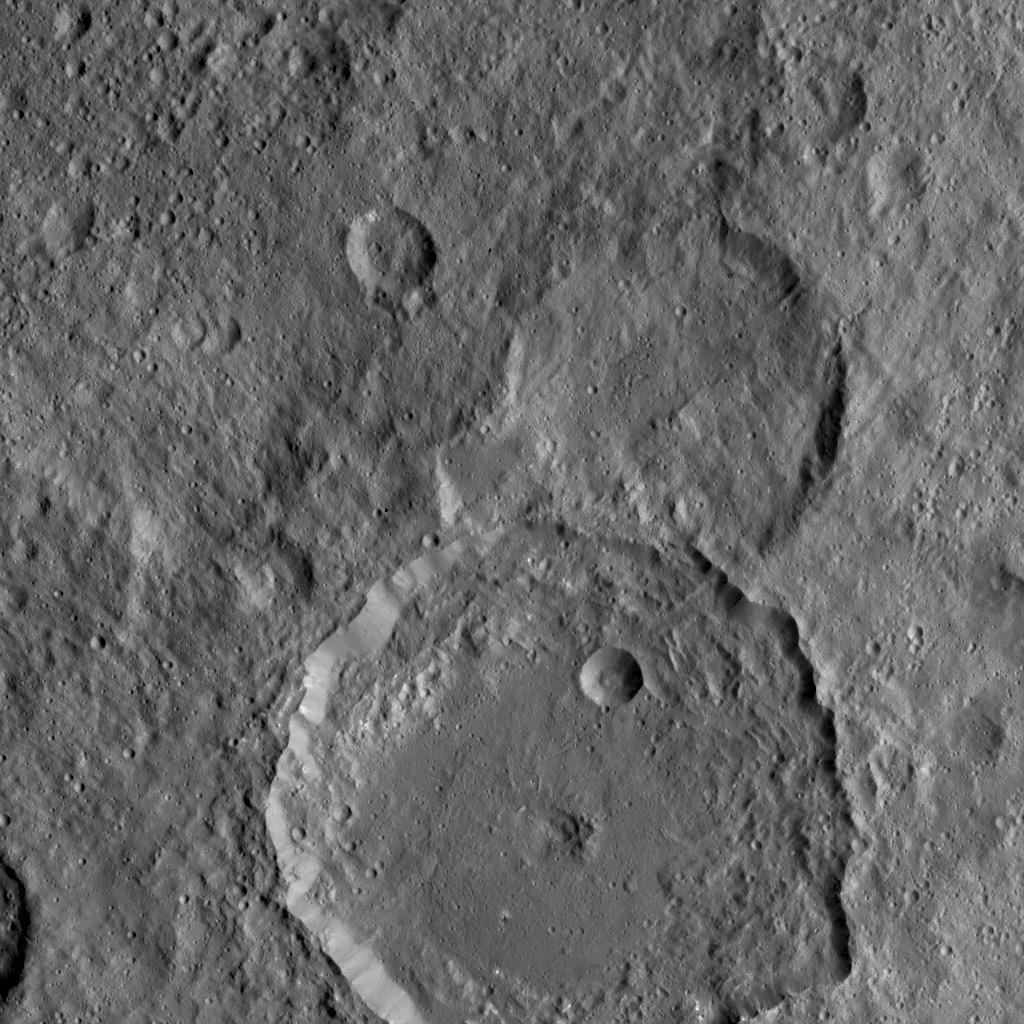Ceres is the largest asteroid in the solar system*. The Dawn spacecraft has been orbiting it since early this year, and a few months ago it spotted something really weird: a 6-kilometer tall mountain just sitting all by its lonesome on the surface.
Since that time Dawn has lowered itself closer to the surface of Ceres, where it can take higher-resolution images. A new photo of the mountain has only made things weirder:

Photo by NASA/JPL-Caltech/UCLA/MPS/DLR/IDA
What the heck is going on with this rock?
The mountain, still unnamed, is just so odd. It sits on what looks like a relatively flat area (though saturated with craters, like the rest of Ceres). It almost looks more like a mesa, with a relatively flat top.
Note the flanks. In this image, the Sun is shining from the right (I flipped it from the original for ease of viewing in a browser), so the right side of the mountain is bright, and the left in shadow—but it turns out that difference in shading is real; one side really is brighter than the other. That’s more obvious in this animated tour of the mountain that uses shading in different images to generate topographical relief:
Note the bright streaks running down the sides. We know Ceres has a lot of water ice in it, but I can’t convince myself that’s what we’re seeing here. The sides of the mountain get a lot of sunlight, and even though Ceres orbits out past Mars, it gets warm enough on its surface that direct sunlight should make the ice sublimate (turn into a gas).
The base of the mountain is pretty sharply defined all the way around. It even looks like there’s a small bit of material piled up around the base on the side facing the crater; you can see slightly brighter arcs here and there. That’s probably mass wasting, material that has slid down the sides. However, there’s not very much of it!
I’m not saying this mountain is a mesa, but suppose for a moment there might be similar processes at work here. Mesas are shaped the way they are due to erosion. What could erode something on Ceres? If the bright stuff really were ice, then you’d expect the material to slump and fall down the sides as the ice sublimates, piling up at the base. We do see some of that, but not nearly enough (see below for more about slumping). That’s one reason why I’m skeptical the bright stuff is ice. The resemblance to a mesa is probably just coincidence. Update, Aug. 26, 2015, at 15:45 UTC: Alan Boyle at Geekwire talked to a planetary scientist who thinks the bright streaks may be from salt. That makes sense, but we still can’t know just yet, since distinguishing salt from ice is very hard with just visible light data.
Dawn was about 1,500 kilometers above Ceres when it took that shot on Aug. 19. In a couple of months it will begin to lower itself to a height of only 375 kilometers! It’ll reach that orbit in December (ion engines are efficient but very low thrust, so it takes a while to change orbits). The resolution will increase by a factor of 4, and features just 150 meters or so across will be visible. Hopefully that will help resolve (literally) some of the mysteries of this bizarre feature. It’ll be interesting to get a better view of the terrain around the mountain, including that soft trough snaking up and slightly around the mountain. Coincidence? Or are they related?
And because why not, here’s another spectacular photo from Dawn:

Photo by NASA/JPL-Caltech/UCLA/MPS/DLR/IDA
Yegads. The big crater at the bottom is called Gaue, and is about 84 kilometers across. Like lots of other craters on Ceres, the rim slopes look steep due to material sloughing off; you can see it piled up all along the inside rim on the crater floor. To my untrained eye, I see a lot of material around it that looks like it might be part of the ejecta apron, material blown out of the crater when it formed. There’s a subtle change in texture near the top left of the image, where I’m speculating the ejecta blanket ended.
Lots of big craters have central peaks, where material rebounds upward after the impact. But the center of this crater is sunken! That may be due to lots of softer material underneath (ice?).
I’ll remind everyone that I’m not a planetary scientist, and while I’m fascinated by geology I’m hardly an expert. But these images are new, and even the Dawn scientists have only just received them. I’ll be very interested to hear their own conclusions.
These images are fantastic, and I can’t wait for December. As amazing as the current data are, those will be even better.
* Some people call it a dwarf planet. I don’t. I got a note from a scientist on the Dawn team who told me they prefer the term “protoplanet”; Ceres and Vesta were both well on their way to becoming full planets before they stopped growing, whereas asteroids tend to be debris, or smaller objects that are fodder for the growth of protoplanets. I rather like that term, and I may have to write up more about it in the future.